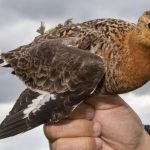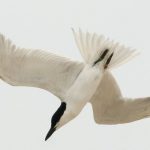← Back
The magical journey of Japanese Swans revealed with Argos
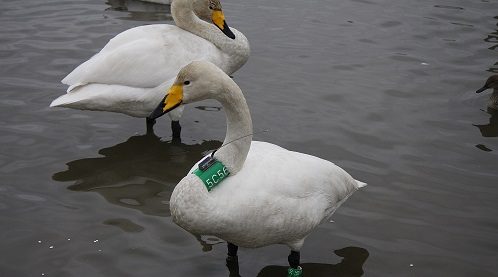
Lake Izunuma-Uchinuma is located in northern Japan, covering an area of 491ha. The lake is renowned internationally for its high biodiversity. It is a Ramsar site, protected by an international treaty for the conservation and sustainable use of wetlands, and it is one of the major wintering sites for waterfowl in Japan. Greater White-fronted Geese are highly represented, with approximately 90% – or one hundred thousand geese – wintering in Japan. A few thousand Whooper Swans also spend the winter at this site. Since the late 1990s, eight waterfowl were equipped with Argos satellite tags and satellite-tracked from this area of Japan.
Photo of Whooper Swan courtesy of K. Tokita.
Argos and Japanese waterfowl
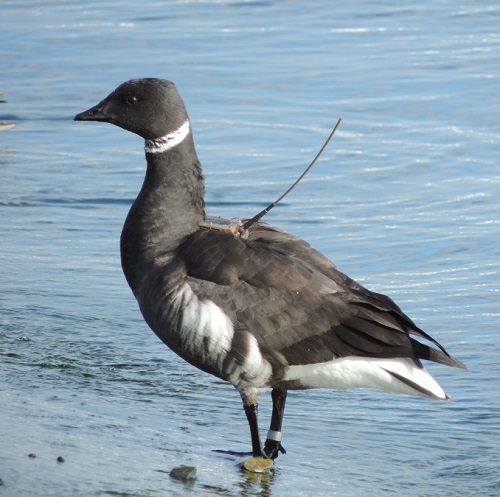
Brent Goose with Argos tag (photograph by T. Shimada).
Among the eight waterfowl that were equipped with Argos satellite tags and satellite-tracked from Japan were Whooper swans and Tundra swans. The Whooper and Tundra Swans departed from northern Japan stopover in eastern Hokkaido, Sakhalin and mouth of the Amur River, and arrived at lower Indigirka and Kolyma River. Argos tracking revealed that the breeding grounds of the Tundra Swans was further North than that of the Whooper Swans.
The Greater White-fronted Geese from northern Japan reached Kharyrka and Pekul’ney through western Hokkaido and the Kamchatka Peninsula. Middendorffii Bean Geese crossed over the Sea of Okhotsk and reached to west of the Kamchatka Peninsula. The Brent Geese followed northward migration routes across the Sea of Okhotsk through eastern Hokkaido.
An impressive voyage
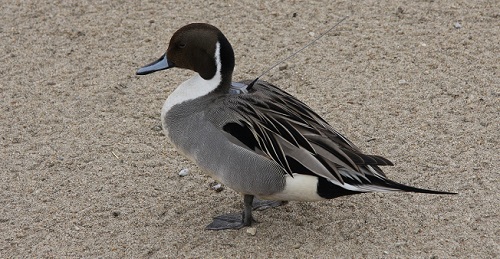
Northern Pintail with Argos tag (photograph by K. Tokita)
Eastern routes of the Mallards crossed over the Japan Sea and arrived at southeastern Russia, and the western one migrated to cross over the Japan Sea and moved to northern China. Northern Pintails also had two migration routes; one arrived at Anadyr lowland through Hokkaido and the Kamchatka Peninsula, and the other migrated to the mouth of the Kolyma River through Hokkaido and costal area of the Sea of Okhotsk. The Baikal Teals started from central Japan and arrived at the mouth of Indigirka and Kolyma River through the Khanka Plain and the Three Rivers Plain. The Argos system makes it possible to track these birds on their incredible journeys.
Dr. Tetsuo Shimada will reveal the mysteries of waterfowl migration that spans several countries and continents at the 2nd Argos Asian Wildlife Tracking Workshop in Incheon, Korea, on July 4th, 2017.
Dr. Tetsuo Shimada
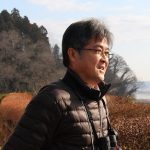
Dr. Tetsuo Shimada
Dr. Tetsuo Shimada works at The Miyagi Prefectural Izunuma-Uchinuma Environmental Foundation in Lake Izunuma-Uchinuma sanctuary center, located on the northern edge of Lake Izunuma, as a general researcher. The foundation operates a facility that engages in conservation activities such as biodiversity restoration and water purification as well as research and promotion of awareness in regards to nature conservation.
Dr. Shimada’s research target species are the waterfowl that winter at Lake Izunuma-Uchinuma. The theme of his doctoral dissertation was the wintering ecology and conservation of Greater White-fronted Geese. So far, he has satellite-tracked Whooper Swans, Northern Pintails and Brent Geese with Professor Dr. Higuchi. His work has made it possible to identify the migration routes for Brent Geese. The results by Argos satellite-tracking greatly encourage to conserve wintering, stopover and breeding sites in their international flyway.

